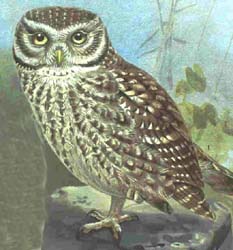Little Owl
|
|
| Little Owl Conservation status: Lower risk (lc) | ||||||||||||||
|---|---|---|---|---|---|---|---|---|---|---|---|---|---|---|
 | ||||||||||||||
| Scientific classification | ||||||||||||||
| ||||||||||||||
| Binomial name | ||||||||||||||
| Athene noctua (Scopoli, 1769) |
The Little Owl (Athene noctua) is a bird which is resident in much of the temperate and warmer parts of Europe, Asia east to Korea, and north Africa. It is not native to Great Britain, but was introduced in the 19th century, and is now naturalised there.
This species is a part of the larger grouping of owls known as typical owls, Strigidae, which contains most species of owl. The other grouping is the barn owls, Tytonidae.
The Little Owl is a small owl, 23-27.5 cm in length. It takes prey such as insects, earthworms and amphibians. It is partly diurnal and often perches prominently.
This is a sedentary species which is found in open country such as mixed farmland and parkland. It usually nests in holes in trees or rocks, laying 3-5 eggs which are incubated by the female for 28-29 days, with a further 26 days to fledging.
The adult Little Owl of the most widespread form, the nominate A. n. noctua, is white-speckled brown above, and brown-streaked white below. It has a large head, long legs, and yellow eyes, and its white “eyebrows” give it a stern expression. This species has a bounding flight like a woodpecker. Juveniles are duller, and lack the adult's white crown spots. The call is a querulous kee-ik.
There is a pale grey-brown Middle Eastern type known as The Syrian Little Owl, or A. n. lilith. Other forms include another pale race, the north African A. n. desertae, and two intermediate subspecies, A. n. indigena of southeast Europe and Asia Minor, and A. n. bactriana of central Asia.
The Little Owl was sacred to the goddess Athena, from whom it gets the generic name.
See also
da:Kirkeugle de:Steinkauz eo:Noktuo lt:Pelėdikė nl:Steenuil pl:Pójdźka
